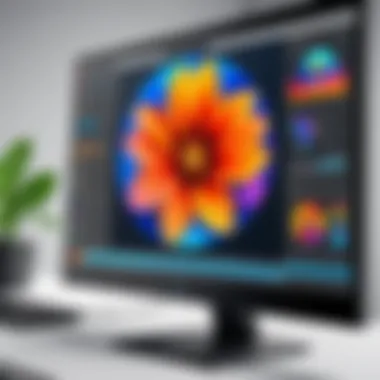Top 27-Inch Monitors for CAD Excellence


Intro
Choosing the right monitor is an important step for professionals in Computer-Aided Design (CAD). A good monitor can significantly enhance workflow and improve productivity. CAD applications often require high levels of detail and precision. Therefore, selecting a monitor that displays accurate colors and finely details graphics matters a lot. The 27-inch monitor size presents a balanced option, providing ample screen real estate without overwhelming the workspace.
In this article, we will explore the best 27-inch monitors tailored for CAD applications. Each model will be dissected based on its specifications and features that contribute to a superior CAD experience. Performance metrics will be examined, assessing how each monitor handles demanding software. Ergonomics also play a role; we will highlight monitors that reduce eye strain, keeping users comfortable during long design sessions.
This guide will offer insights into various models, enabling professionals to make informed decisions based on their unique CAD needs. From color accuracy to connectivity options, everything that enhances creativity and productivity will be considered.
Prelude to CAD and Monitor Requirements
Computer-Aided Design (CAD) is an essential tool in various industries, including architecture, engineering, and product design. Choosing the right monitor becomes crucial for professionals who rely on CAD applications. The display not only showcases designs but also influences productivity and comfort during long hours of work. A high-quality monitor helps ensure that details are sharp and colors are accurate, making it easier to identify errors or make adjustments in designs.
Understanding CAD
CAD refers to the use of computer software to create precision drawings, technical illustrations, and 3D models. It allows professionals to visualize their concepts before actual production or construction begins. CAD programs commonly utilize complex graphics that require robust hardware. Therefore, the monitor is a critical component of this setup. It must be capable of accurately displaying intricate designs and colors.
High screen resolution is often necessary for seeing fine details. CAD applications demand a lot from hardware, making screen size and quality important. A 27-inch monitor offers a balance between workspace and details displayed clearly.
Significance of Monitor Quality
The quality of a monitor can significantly affect CAD work. Several aspects of the monitor contribute to this. Color accuracy is paramount; errors due to poor color fidelity can lead to significant design flaws. A monitor with good calibration ensures colors match the intended design or specifications.
Moreover, a decent refresh rate and response time are also important but often overlooked. A high refresh rate makes animations and movements smoother, while low response time minimizes ghosting effects. These technical aspects contribute to a fluid user experience, especially when navigating complex models.
The build and ergonomics of the monitor are also noteworthy. An adjustable stand or VESA mount compatibility provides flexibility, which is essential for maintaining comfort during long working sessions. A well-designed workspace can prevent physical strain, enhancing overall productivity and creativity.
"The right monitor can transform how CAD professionals work, leading to a more efficient and enjoyable experience."
In summary, understanding the role of monitors in CAD applications is foundational for making informed choices. The next parts will dive deeper into specific features and specifications that CAD users should prioritize when selecting their equipment.
What to Look for in a 27-Inch Monitor for CAD
In Computer-Aided Design (CAD), the choice of monitor is paramount. A 27-inch monitor provides a balance between screen real estate and workspace requirements. This section delves into the critical specifications and features that CAD users should consider to enhance their workflow and minimize eye strain.
Screen Resolution and Aspect Ratio
Screen resolution is crucial for CAD applications. A higher resolution enables users to view more detail in their designs, making it easier to spot imperfections and nuances. Common resolutions for 27-inch monitors include 2560 x 1440 (QHD) and 3840 x 2160 (4K). The aspect ratio should also be considered; a 16:9 aspect ratio is standard. However, some may prefer ultrawide formats for multitasking.
Color Accuracy and Calibration
Color accuracy is vital in CAD design work. Accurate colors ensure that the designs and visuals you produce look as intended when printed or displayed elsewhere. Look for monitors with an sRGB coverage of at least 99% for reliable colors. Additionally, factory calibration or tools for manual calibration are essential for maintaining color fidelity across different projects.
Refresh Rate and Response Time
While CAD work is not as dependent on high refresh rates as gaming, a good refresh rate can improve overall user experience. A refresh rate of 60Hz is usually adequate. Response time should also be low, ideally below 5ms, to prevent ghosting effects when the screen updates quickly.
Panel Technology Explained
IPS vs. TN vs. VA
Panel technology affects color reproduction, viewing angles, and overall performance. IPS panels are popular for CAD because of their superior color accuracy and wide viewing angles. Although TN panels are cheaper and offer faster refresh rates, they lack in color depth. VA panels provide better contrast but can struggle with viewing angles.
Viewing Angles


Viewing angles impact how the monitor's display can be viewed from different positions. IPS panels provide superior viewing angles, allowing multiple users to see the screen without color distortion. This is particularly useful in collaborative environments. Choosing a monitor with wider viewing angles can greatly enhance usability in CAD tasks.
Connectivity Options
Effective connectivity ensures that the monitor integrates smoothly with various devices. Look for monitors that offer HDMI, DisplayPort, and USB-C connections. Compatibility with different video outputs allows flexibility in connecting to various workstations or laptops, essential for CAD professionals who may switch devices frequently.
Ergonomics and Design
A well-designed monitor promotes comfort during long hours of work. Ergonomics should be a priority in your selection process.
Adjustable Stands
Monitors with adjustable stands allow for better customization of viewing height and angle. This helps reduce neck strain and promotes a more comfortable work posture. Adjustable stands are beneficial for CAD users who spend hours in front of the screen.
VESA Mount Compatibility
VESA mount compatibility is an important feature. This allows you to mount the monitor on adjustable arms or wall brackets. It saves desk space and helps in achieving the best viewing position according to personal needs. With VESA compatibility, you can also easily switch between different setups as per project requirements.
Choosing the right features in a 27-inch monitor can significantly impact your overall CAD experience. Understanding these specifications is the first step towards making an informed purchase.
Top Picks for 27-Inch Monitors in CAD
Selecting a monitor for Computer-Aided Design (CAD) can significantly affect one’s design process, comfort and overall productivity. In this section, we delve into the top picks for 27-inch monitors suitable for CAD applications. These monitors offer specific characteristics that facilitate precision, clear visuals, and ergonomic benefits, all critical for successful CAD work.
Not every monitor can handle the demands of CAD software, which requires clarity and color accuracy. The models we discuss here have been selected for their exceptional performance metrics. Moreover, the importance of a monitor's specifications cannot be overstated. High screen resolution and color fidelity enhance the visualization of designs. Thus, making an informed decision empowers professionals to maximize their workflows.
Monitor A: Detailed Review
Performance Metrics
The performance metrics significantly affect user experience in CAD applications. Monitor A excels with a 4K UHD resolution, providing sharp details that are essential for intricate designs. Its high brightness level and contrast ratio contribute to vibrant colors and deep blacks, enhancing visibility in varying lighting conditions. This monitor's low input lag allows for fluid movements and reduces latency, a critical factor when working on detailed designs that require precision.
Pros and Cons
One of the main advantages of Monitor A is its superior color accuracy, which is vital for design work. It supports 99% sRGB coverage, ensuring that colors are represented faithfully. However, its higher price point may be a limitation for some users, making it less accessible. Overall, this monitor is a beneficial choice for CAD professionals who prioritize visual integrity and responsiveness in their work.
Monitor B: Detailed Review
Performance Metrics
Monitor B offers an impressive refresh rate of 144Hz, making it popular among those who value real-time responsiveness. Its 2560x1440 resolution provides a solid balance between detail and performance, making it suitable for CAD and general use. Furthermore, the monitor includes customizable settings, enabling users to adjust parameters according to their workflow, enhancing comfort.
Pros and Cons
While Monitor B is lauded for its impressive refresh rate, it does come with limitations. The color representation is decent, but it doesn't reach the standards seen in higher-end models. Still, its competitive price makes it an attractive option for those looking to invest in a reliable monitor without breaking the bank.
Monitor C: Detailed Review
Performance Metrics
Monitor C stands out for its advanced IPS panel technology, which ensures superior viewing angles and color consistency. This is particularly important when collaborating with team members or stakeholders, as it allows multiple users to see the same vibrancy across different angles. The monitor also features adaptive sync technology, which eliminates screen tearing, making design sessions smoother.
Pros and Cons


The wide angle viewing capability is a notable strength for Monitor C. However, some users may find its brightness levels to be less than ideal for bright workspaces. This trade-off highlights the importance of considering the environment in which the monitor will be used. Nonetheless, its overall performance solidifies its place among the top choices for CAD applications.
Monitor D: Detailed Review
Performance Metrics
Monitor D features a robust build with a resolution of 1920x1080. Though it is lower than some competitors, it uses exclusive display technology that enhances color performance. This makes it suitable for designers who work with less complex applications, or for users who integrate it into a multi-monitor setup.
Pros and Cons
A significant benefit of Monitor D is its budget-friendly nature, offering good performance without a hefty price tag. While it may not be the first choice for high-end CAD tasks, it provides sufficient capability for everyday work. Its entry-level price can deter some users looking for high fidelity but remains appealing for certain professionals and students.
The choice of monitor plays an essential role in the user’s overall design experience.
This section presents a range of options suitable for CAD applications. Each monitor possesses unique qualities that can cater to various preferences and budgets.
Comparative Analysis of Best Picks
In evaluating monitors suitable for CAD applications, a comparative analysis serves as an essential tool to discern the ideal choice among various options. An effective comparative analysis allows designers and engineers to assess critical features side by side. This section outlines how this analysis benefits users, ensuring they make informed decisions that cater to their specific work demands. Understanding key differentiators in monitor performance, functionality, and usability leads to enhanced productivity and reduced eye strain.
This analysis considers factors like screen resolution, color accuracy, refresh rates, and panel technologies. With numerous brands and models available, a structured comparison can simplify the selection process. Potential buyers can focus on their priorities, whether they seek affordable options or high-end models.
Side-by-Side Comparison Chart
The side-by-side comparison chart synthesizes vital metrics of each monitor. Such a chart provides a snapshot that highlights specifications alongside performance ratings. Here’s an example of what this chart may include:
| Feature | Monitor A | Monitor B | Monitor C | Monitor D | | Resolution | 2560 x 1440 | 1920 x 1080 | 3840 x 2160 | 2560 x 1440 | | Color Accuracy | 99% Adobe RGB | 90% Adobe RGB | 100% Adobe RGB | 95% Adobe RGB | | Refresh Rate | 60 Hz | 75 Hz | 60 Hz | 100 Hz | | Panel Technology | IPS | TN | OLED | VA | | Ergonomics | Adjustable Stand | Fixed Stand | Adjustable Stand | Fixed Stand |
A clear side-by-side analysis reveals critical insight into each monitor’s offerings, aiding in making a well-informed purchase.
Strengths and Limitations
When selecting a monitor for CAD work, it is crucial to weigh the strengths and limitations of each option. Here is a concise breakdown for the monitors in consideration:
- Monitor A:
- Monitor B:
- Monitor C:
- Monitor D:
- Strengths: Exceptional color accuracy; Ideal for detailed graphic work.
- Limitations: Higher price point may not fit all budgets.
- Strengths: Good refresh rate and value for money.
- Limitations: Average color accuracy and smaller resolution.
- Strengths: Best-in-class resolution with perfect color reproduction.
- Limitations: Higher energy consumption may be a concern for some users.
- Strengths: Adjustable ergonomics for comfort during long work hours.
- Limitations: Slower response time can affect fast-paced design scenarios.
This analysis helps CAD professionals focus on what features are most vital to their work while balancing performance with budgetary considerations.
User Experiences and Feedback
User experiences and feedback play a crucial role in understanding how 27-inch monitors perform in real-world CAD applications. Professionals in the field have unique needs based on their specific workflows. Feedback from these users can highlight both the strengths and weaknesses of different models, giving prospective buyers a more grounded perspective.
When considering user experiences, it's important to note that they typically allocate unique weight to attributes such as image clarity, comfort during extended use, and how well different monitors handle CAD software requirements. Gathering such perspectives provides valuable insights into the actual performance of monitors, empowering users to make informed choices.
CAD Professionals’ Perspectives


CAD professionals often evaluate monitors based on a few critical criteria. They prioritize factors like color accuracy, viewing angles, and ergonomic features. For instance, a designer might share their thoughts on how a certain monitor reproduces colors accurately. Color reproduction is vital for CAD work, as slight discrepancies can lead to inaccuracies in designs.
Another common perspective involves the working comfort offered by a monitor. CAD tasks can demand hours of attention. Thus, professionals frequently mention how the ergonomics of a monitor, like adjustable height and tilt, affect their workflow. The sentiment from users often reinforces the need for high-quality stands or VESA mount compatibility, ensuring flexibility in setting up their work environment.
Common Complaints and Praise
Like any product, 27-inch monitors face both praise and criticism. Common complaints include issues related to poor color calibration out of the box or inconsistencies in performance during fast-moving graphic displays. Users may express frustration when monitors do not meet their color profile needs, especially when working with detailed designs.
On the contrary, many professionals praise monitors that offer excellent refresh rates and low response times, which enable a smoother design experience. Additionally, positive feedback frequently centers on robust connectivity options such as USB-C or DisplayPort, which facilitate a straightforward connection to various devices.
"A reliable monitor can significantly impact a designer's productivity and reduce eye strain, making thorough evaluations essential."
Understanding these insights helps potential buyers navigate their options more effectively and consider what aspects matter most to their particular needs.
Budget Considerations for CAD Monitors
Selecting a monitor for Computer-Aided Design (CAD) involves more than just deciding on the technical specifications. Budget is one of the crucial factors that influence the final choice. Understanding how to navigate the budget spectrum can help you find a suitable option without sacrificing quality. Depending on your professional needs, a versatile monitor can enhance your workflow and contribute significantly to productivity.
When considering a budget, two main categories emerge: affordable options and premium choices. Each of these categories has distinct features and advantages, making it essential to weigh them carefully against your requirements.
Affordable Options vs. Premium Choices
Affordable options often come with basic display features and may lack some specialized capabilities needed for intensive CAD work. These monitors usually have satisfactory color accuracy and resolution but might not reach the higher standards set by premium models. They are ideal for casual users who may not require detailed graphics or explicit detail in their designs. Some key points about affordable monitors include:
- Price-Friendly: Generally more budget-conscious, making them accessible to a broader audience.
- Basic Features: Sufficient for general CAD applications, but may underperform in color accuracy or refresh rates.
- Wider Selection: Many brands offer various models, allowing room for user preference.
On the other hand, premium choices cater to professional needs, offering advanced specifications that can provide a greater edge in performance. Although they come at a higher cost, the investment often pays off in usability and extended longevity. Key points of premium monitors include:
- Superior Color Accuracy: Essential for design work, as it ensures that what you see on-screen closely matches the printed project.
- High Refresh Rates and Response Times: Facilitate smoother operation, particularly important for animations or moving graphics within CAD software.
- Ergonomic Features: Many premium monitors come with adjustable stands and wider viewing angles for comfort during extended work sessions.
Long-Term Value Analysis
Examining the long-term value of a monitor is crucial for understanding your investment's efficacy. While the initial outlay might be higher for premium options, these monitors often come equipped with features that promote a longer lifespan and enhanced performance over years of use.
When analyzing long-term value, consider the following:
- Durability: Premium monitors often use higher-quality components that can withstand prolonged use without significant wear and tear.
- Future-Proofing: As software becomes more demanding, high-end monitors tend to adapt better, maintaining relevance even as technology evolves.
- Support and Warranty: Many premium brands offer extended support services and warranties, which can alleviate costs of repairs or replacements down the road.
Investing a reasonable budget now can save considerable costs in the future. An informed choice can help leverage your CAD efforts while providing the necessary tools to achieve outstanding results effectively and efficiently.
End: Making an Informed Choice
Choosing the right monitor is a pivotal decision for CAD professionals. Selecting an optimal 27-inch monitor can significantly affect productivity, accuracy, and overall experience in design tasks. A well-informed choice involves strong knowledge of the essential specifications that relate directly to CAD applications. Understanding how factors like screen resolution, color accuracy, and panel technology can impact your daily work is essential.
This article stresses the importance of comprehensively analyzing each option on the market. CAD involves intricate designs, and a monitor that cannot accurately represent those designs will lead to frustration and possible errors. The right monitor should not only meet the basic requirements but also enhance the user’s experience through ergonomic design that minimizes fatigue.
Furthermore, your choice should align with your budget while considering long-term value. With a wide array of models available, weighing the strengths and weaknesses of each will guide you to an informed decision that serves both immediate and future needs.
"In the realm of CAD, a monitor isn’t just a display; it’s a vital tool for accomplishing precision work that influences complex projects."
Recap of Key Insights
- Screen Resolution and Color Accuracy: High resolutions and precise color representation are critical for CAD tasks. This ensures that designs are depicted accurately.
- Refresh Rate and Response Time: While these specifications matter less in CAD than in gaming, they still influence how fluid the interaction with the software feels.
- Panel Technology: The choice between IPS, TN, and VA technologies can affect viewing angles and color reproduction, which are important for long hours of design work.
- Ergonomics: An adjustable stand and VESA mount compatibility can significantly enhance comfort during extended use, reducing eye strain.
- Connectivity: Sufficient ports ensure compatibility with various devices, which is essential in a professional setting.
Final Recommendations
When finalizing your choice, consider the following recommendations:
- Look for monitors with at least 2560x1440 resolution, which provides enough detail for CAD operations.
- Ensure that the monitor has a color accuracy rating of at least 99% sRGB, which aids in achieving the necessary precision in your work.
- Select options with IPS panels for better viewing angles and color consistency, vital for team collaborations.
- Consider monitors that allow for ergonomic adjustments; this feature will protect your health and improve your efficiency.
- Keep a budget range of $300 to $800, as many excellent models fall within this spectrum, balancing performance and price.







